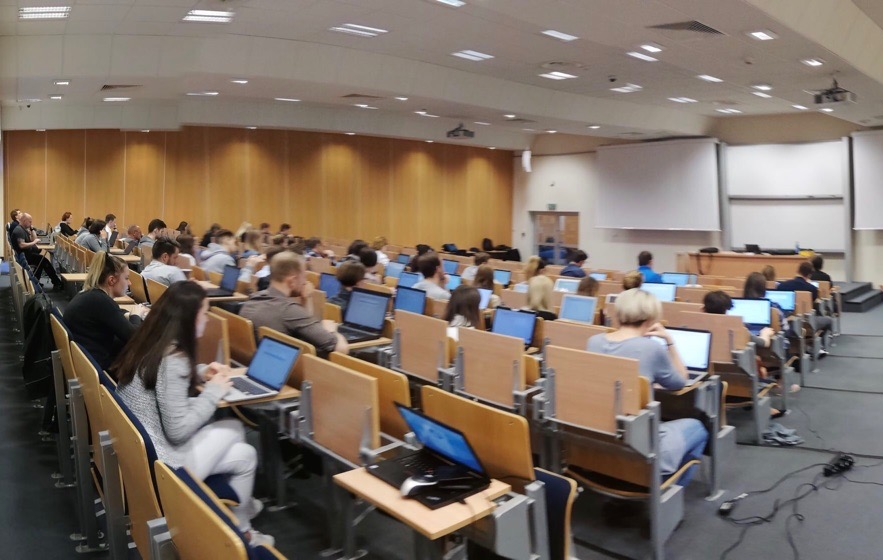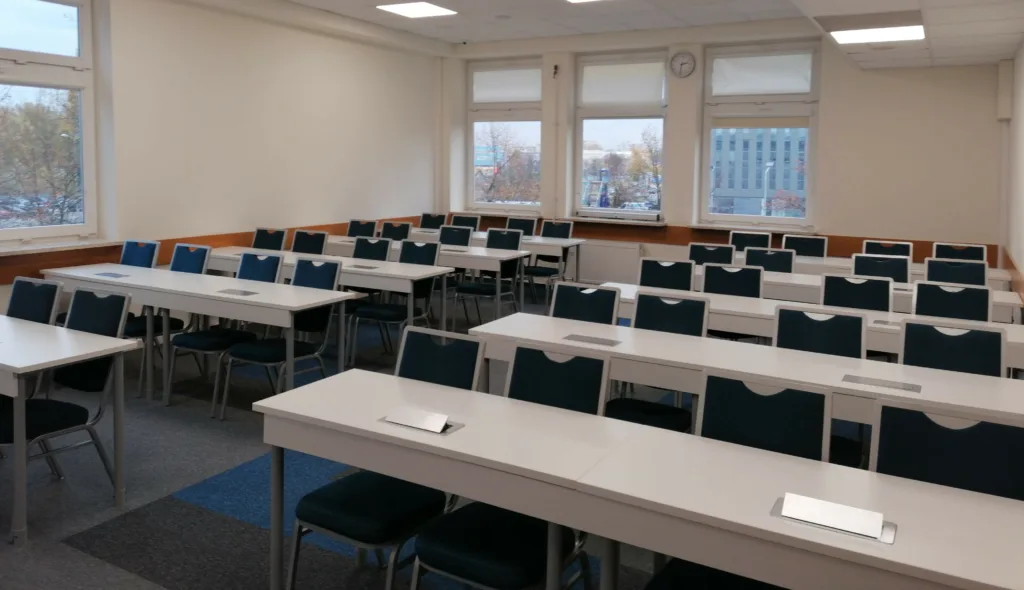
As a result of strong demand from the faculty staff, Kozminski University in Warsaw, Poland, has invested in three highly modern auditoriums suitable for Bring Your Own Device (BYOD) exams and classes. Successfully running a BYOD exam for 200 persons in the spring was a breakthrough for the University. The ambition: to give even more students the ability to use their own computers when sitting an exam.
It – almost – feels like home when students at the private business school open their laptops and get ready to sit an exam in one of the three brand new auditoriums. Bring Your Own Device (BYOD) refers to the practice of students using their personal devices for educational purposes – e.g. an exam.
‘An exam can be stressful, so we really want our students to be as comfortable as possible. With BYOD, the students can carry out their exam on a personal computer which they are familiar with. It makes them feel more confident about themselves and the exam situation. Eventually, it is likely they will perform better and spend less time on practicalities,’ says Valeriia Gorlushko, Head of EdTech Centre at Kozminski University.
The team at the EdTech Centre has to handle the students’ concerns when they are to sit a digital exam. Good communication is the road to a successful BYOD exam, Gorlushko explains. Keeping your students well informed at all times is a way to reduce stress and to limit the number of potential pitfalls on the exam day.


From left to right: Valeriia Gorlushko and Michał Wiechete, EdTech Centre; A BYOD exam at Kozminski University
The university’s motivation for implementing BYOD exams
The main reason for scaling up BYOD exams was the limitations of the eight computer labs the University already had at their disposal. Even though the computer labs contained 300 computers in total, it was not enough to meet the needs of teachers who wanted their exams to be available digitally. With BYOD, it was easy to scale-up the number of students who could sit an exam on the same day, even though the university couldn’t provide all of them with a computer.
‘Of course, it has been a cost to recondition the auditoriums and make them suitable for BYOD exams and classes. A project manager from our infrastructure department was in charge of the modernisation, which included stable wi-fi and special desks with sockets for charging laptops.
We see it as a long term investment that will be of great value for both students and staff for years to come,’ Valeriia Gorlushko explains.
Another obvious benefit for the University is that it will spend fewer resources on hardware and maintenance in the future when students bring their own computers to the exam rooms. And then there is the question about sustainability to be considered as well, Michał Wiechetek from the EdTech Centre points out. The reduction of the use of paper and electricity aligns with the University’s sustainability goals and the institution’s desire to reduce its carbon footprint.
BYOD is an addition to an already successful transition to digital exams
Kozminski University introduced digital examinations with Inspera Assessment in 2017. As early as 2014, the University trialled another online assessment tool and realised that the faculty members were highly motivated for proceeding with online exams. The wide range of question types in Inspera Assessment enabled them to scale and to digitise subjects such as Finance and Accounting.
‘When implementing digital exams, we experienced that we could gain higher quality with less time spent. Usually, it is the other way around. Digital exams have basically changed the way we work and have made it much easier to share the responsibilities connected with the assessment process,’ underlines Valeriia Gorlushko.

Picture: one of the new auditoriums suitable for Bring Your Own Device (BYOD) exams
BYOD exams at Kozminski University are here to stay and to be scaled and developed in the future. A few professors at the University have even stated that they only want to do BYOD exams going forward. Michał Wiechetek explains that BYOD exams are part of the University’s initiatives on digital transformation on a large scale.
‘To sit a digital exam should be just as easy as to take a piece of paper and start writing on it. Further down the line online exams should even be independent of time and place, this way making examinations even more seamless,’ Michał Wiechete says.
Do you want to learn more?
In 2018, Kozminski University conducted 5 BYOD exams. This year, the University has already run 16 BYOD exams in the spring semester, and with the new auditoriums being ready for the fall semester, the numbers will only increase. If you want to know more about how Kozminski University has successfully transferred from paper to digital exams, you can read the customer case study.



